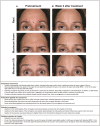Integrative Assessment for Optimizing Aesthetic Outcomes When Treating Glabellar Lines With Botulinum Toxin Type A: An Appreciation of the Role of the Frontalis
- PMID: 36322138
- PMCID: PMC10638666
- DOI: 10.1093/asj/sjac267
Integrative Assessment for Optimizing Aesthetic Outcomes When Treating Glabellar Lines With Botulinum Toxin Type A: An Appreciation of the Role of the Frontalis
Abstract
Despite the perception that treatment of glabellar lines with botulinum toxin A is straightforward, the reality is that the glabellar region contains a number of interrelated muscles. To avoid adverse outcomes, practitioners need to appreciate how treatment of 1 facial muscle group influences the relative dominance of others. In particular, practitioners need to understand the independent role of the frontalis in eyebrow outcomes and the potential for negative outcomes if the lower frontalis is unintentionally weakened by botulinum toxin A treatment. In addition, practitioners must recognize how inter-individual variation in the depth, shape, and muscle fiber orientation among the upper facial muscles can affect outcomes. For optimal results, treatment of the glabellar complex requires a systematic and individualized approach based on anatomical principles of opposing muscle actions rather than a one-size-fits-all approach. This review provides the anatomical justification for the importance of an integrated assessment of the upper facial muscles and eyebrow position prior to glabellar treatment. In addition, a systematic and broad evaluation system is provided that can be employed by practitioners to more comprehensively assess the glabellar region in order to optimize outcomes and avoid negatively impacting resting brow position and dynamic brow movement.
© The Author(s) 2022. Published by Oxford University Press on behalf of The Aesthetic Society.
Figures








References
-
- Kaminer MS, Cox SE, Fagien S, Kaufman J, Lupo MP, Shamban A. Re-examining the optimal use of neuromodulators and the changing landscape: a consensus panel update. J Drugs Dermatol. 2020;19(4):s5–s15. - PubMed
Publication types
MeSH terms
Substances
Grants and funding
LinkOut - more resources
Full Text Sources
Medical

